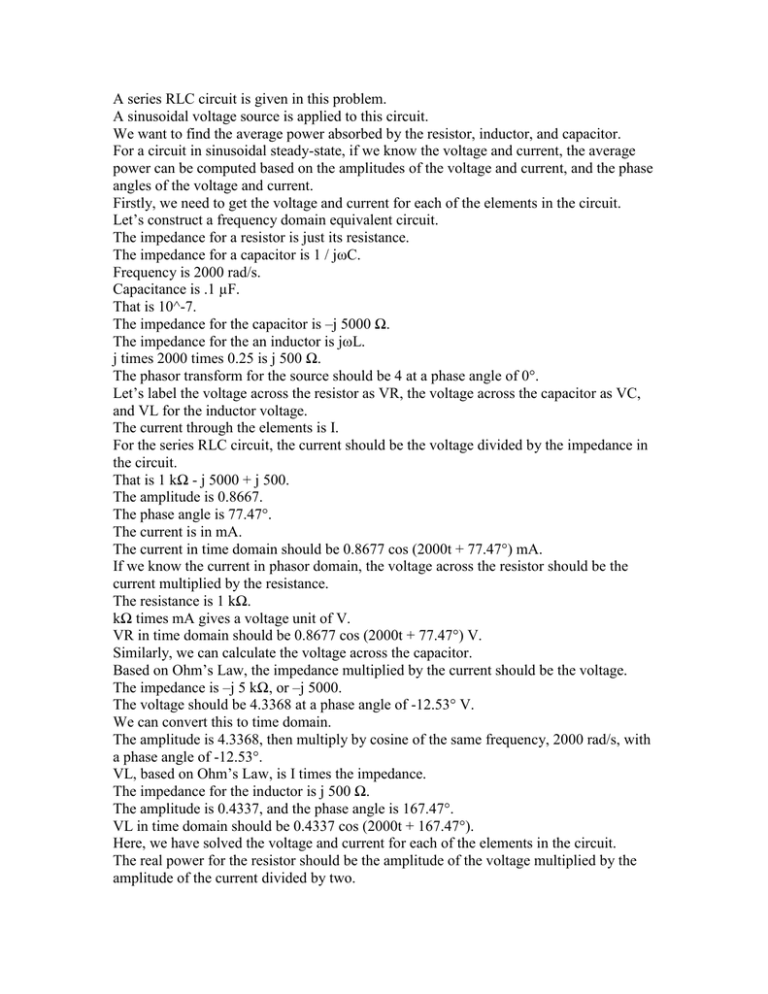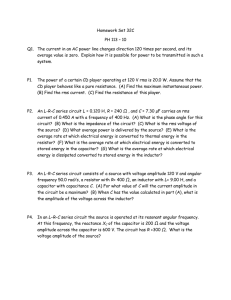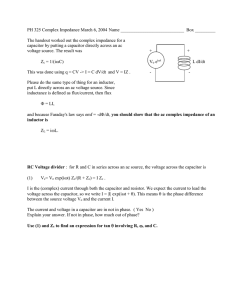A series RLC circuit is given in this problem.
advertisement

A series RLC circuit is given in this problem. A sinusoidal voltage source is applied to this circuit. We want to find the average power absorbed by the resistor, inductor, and capacitor. For a circuit in sinusoidal steady-state, if we know the voltage and current, the average power can be computed based on the amplitudes of the voltage and current, and the phase angles of the voltage and current. Firstly, we need to get the voltage and current for each of the elements in the circuit. Let’s construct a frequency domain equivalent circuit. The impedance for a resistor is just its resistance. The impedance for a capacitor is 1 / jωC. Frequency is 2000 rad/s. Capacitance is .1 µF. That is 10^-7. The impedance for the capacitor is –j 5000 Ω. The impedance for the an inductor is jωL. j times 2000 times 0.25 is j 500 Ω. The phasor transform for the source should be 4 at a phase angle of 0°. Let’s label the voltage across the resistor as VR, the voltage across the capacitor as VC, and VL for the inductor voltage. The current through the elements is I. For the series RLC circuit, the current should be the voltage divided by the impedance in the circuit. That is 1 kΩ - j 5000 + j 500. The amplitude is 0.8667. The phase angle is 77.47°. The current is in mA. The current in time domain should be 0.8677 cos (2000t + 77.47°) mA. If we know the current in phasor domain, the voltage across the resistor should be the current multiplied by the resistance. The resistance is 1 kΩ. kΩ times mA gives a voltage unit of V. VR in time domain should be 0.8677 cos (2000t + 77.47°) V. Similarly, we can calculate the voltage across the capacitor. Based on Ohm’s Law, the impedance multiplied by the current should be the voltage. The impedance is –j 5 kΩ, or –j 5000. The voltage should be 4.3368 at a phase angle of -12.53° V. We can convert this to time domain. The amplitude is 4.3368, then multiply by cosine of the same frequency, 2000 rad/s, with a phase angle of -12.53°. VL, based on Ohm’s Law, is I times the impedance. The impedance for the inductor is j 500 Ω. The amplitude is 0.4337, and the phase angle is 167.47°. VL in time domain should be 0.4337 cos (2000t + 167.47°). Here, we have solved the voltage and current for each of the elements in the circuit. The real power for the resistor should be the amplitude of the voltage multiplied by the amplitude of the current divided by two. [equation] The real power, or average power, is 0.0817 mW. To get the real power for the capacitor, we can similarly use the voltage and current amplitude, and also the phase angle for the voltage and current. [equation] Notice that -12.53° - 77.47° is exactly cos(-90°). cos(-90°) is 0. For the inductor, the average power is the amplitude of the voltage multiplied by the amplitude of the current. The phase angle difference is 167.47° - 77.47°. We get cos(90°). cos(90°) is 0, so the average power for the inductor should be 0 W. Notice the capacitor and inductor do not consume any real power or average power.









